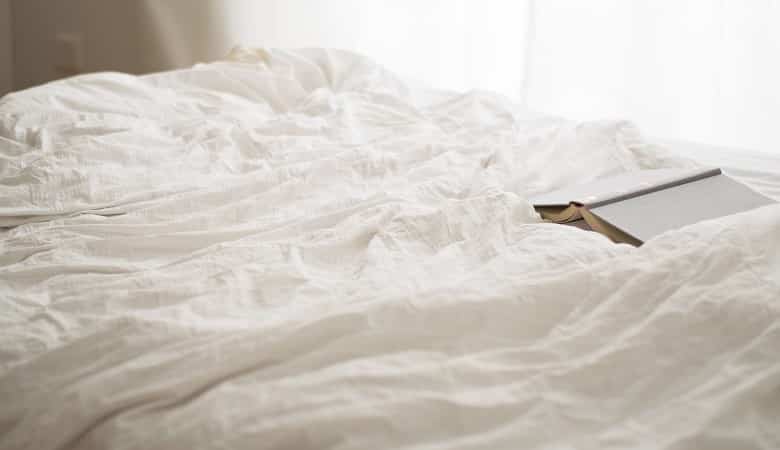Nothing is more relaxing than getting into bed after a long, hard day and snuggling in between soft, clean bedsheets. Soft, clean sheets get you in the mood for sleep.
But what if your sheets are worn? How does that feel? Do worn sheets welcome sleep? If you’ve ever wondered how often you should buy new sheets, we’ll answer that for you today.
How often should you buy new sheets? Most manufacturers would suggest buying new sheets every two to three years. However, some factors to take into consideration before deciding when you should buy new sheets are: (1) knowing what your sheets are made of, (2) knowing how much you sweat in your sleep, (3) and knowing how often you wash your sheets.
All of these factors together help to decide when it’s time to buy new sheets. The best answer is it’s time to buy new sheets when you see obvious signs of aging, such as stains, fraying hems, or faded patterns.
What Fabric Are Your Sheets Made of

It’s not always easy knowing the best quality fabric to buy when you’re looking for the perfect set of sheets. There are a lot of fabrics to choose from:
Cotton
Cotton is a good, quality fabric for sheets. It’s also one of the most popular fabrics used to make sheets and other bedding. Cotton is durable, breathable, soft, easy to care for, and affordable. There’s more than one type of cotton fabric to consider:
- Egyptian Cotton – The most luxurious cotton fabric. It’s super-soft and of high quality. Primarily grown in the warm, dry climates of North Africa.
- Pima Cotton – Soft cotton with a natural sheen. Primarily grown in the southwest of the U.S.
- Upland Cotton – The most commonly grown cotton in the world. Most cotton sheets, unless specified otherwise, are made of Upland cotton, especially if they are bargain priced. Not as soft as Egyptian or Pima. Grown in the U.S.
- Supima – The trademarked name for fibers and materials woven from 100% American Pima cotton.
- MicroCotton – Very soft and absorbent. A trademarked brand of extremely fine cotton thread developed in India.
- Cotton Jersey – Sheets made from cotton fabric that is knit rather than woven. The same fabric used in cotton t-shirts.
- Percale – A closely woven cotton fabric with a plain weave.
- Combed cotton – Cotton fabric that has been treated to remove all the short fibers during the manufacturing process, leaving a very smooth fabric.
- Flannel – Cotton fabric that’s been combed to fluff up the fibers. A very soft fabric with a nap that traps body heat, thus giving flannel its snuggly-warm qualities.
Tencel
Tencel fabric is made out of eucalyptus tree wood pulp. It’s soft, very durable, and naturally antimicrobial. This is considered the environmentally friendly fabric since its production requires less water, energy and chemicals than is needed to produce cotton.
Silk
Silk is a luxurious, soft fiber – it’s cool, silky and sensuous. It’s also naturally hypoallergenic. Silk is more expensive than the other fabrics and requires delicate care maintenance.
Polyester
Polyester is a man made fiber produced from the same polymers used to make plastic drink bottles. It’s inexpensive, but stiff and scratchy when used by itself, which is why you’ll usually find it mixed with another fiber.
- Microfiber – Very finely woven polyester that is soft, but not as breathable as cotton. However, they are durable.
- Nylon – A strong and durable synthetic fabric that can make for soft and satiny sheets that do not wrinkle. This fabric can be problematic after a few washings. Can start to pill up and does not hold up well under the heat of a dryer.
- Acrylic – A synthetic fiber that is not as comfortable against the skin as natural fiber. However, it’s wrinkle resistant.
Bamboo
Bamboo is stiff and rough. The chemical process it goes through produces a very soft, durable and silky sheet fabric.
Blends
There are lots of blended fabrics available, that mostly include some form of cotton. Cotton/polyester is the most common. Blended fabrics are usually inexpensive, durable, and wrinkle-resistant.
Thread Count
Thread count is the number of threads woven together per square inch of fabric. It consists of the vertical threads and the horizontal threads woven together. A common misconception is the higher the thread count, the better the quality of the sheet.
Thread count can be as high as 800, but good, quality sheet sets will have a thread count between 300 and 500. Single-ply threads are of the most quality; higher thread counts require 2-ply yarns and/or multi-picks be used.
Night Sweats
If you wake up in the middle of the night drenched from head to toe in sweat, you are a heavy sweater. This sweat gets in your sheets, and they feel like they just came out of the washing machine. That is not a good feel for sheets or a good sense of cleanliness.
If this happens often, hopefully you are washing your sheets at least once a week. Otherwise, the stench and staining from your body will eventually discolor your sheet and cause it to look worn way before its time.
Washing Your Sheets

Frequent washing of your sheet will cause them to wear out, but in order to keep your sleeping space sanitary and to maintain your sheets longevity, they should be washed every 7 to 14 days. Factors to consider when deciding how often you should wash your sheets are:
- If you have allergies or asthma and are sensitive to dust;
- If you have an infection or lesion that makes contact with your sheets;
- If you sweat excessively;
- If you have pets that sleep in your bed;
- If you eat in the bed;
- If you go to bed without showering;
- If you sleep naked.
It’s best to wash your sheets on a cool or warm cycle. This will help them to maintain their color and elasticity. Do not overload the washer; wash one set of sheets at a time.
Use a mild detergent and never pour detergent directly onto the sheets. Stay away from using an excessive amount of detergent, as this can coat the sheets and make them feel rough. Be very careful about using bleach to sanitize your sheets. Bleach has been known to degrade the fabric, causing it to age faster.
It’s always best to line dry; if that’s not an option, then tumble dry in the dryer. Heat can shrink cotton fibers.
If you don’t need to use the sheets immediately after cleaning them, make sure to properly store them in a cool, dry place like a linen closet, drawer, or under-the-bed container. Never place them back in the plastic covering they were in when you purchased them.
5 Things to Know Before Buying New Sheets
Once it’s been determined from all of the factors above that it’s time to buy new sheets, here are five things we recommend before buying:
- Read the fiber content. 100% cotton is always a good choice. It’s soft and affordable.
- More thread count isn’t always better. Stick to a 300 to 500 thread count.
- Know the difference between weaves. Stick to a percale or sateen weave.
- Don’t assume it’ll fit your mattress. Standard sizes, like queen or king, don’t account for mattress depth. Also, account for shrinkage after cleaning.
- Always check the return policy.
In conclusion, only you know the factors concerning your sheets. With proper care, you should not see a need to buy new ones before two years. If you have not bought new sheets in over three years, it’s time for some new ones.
